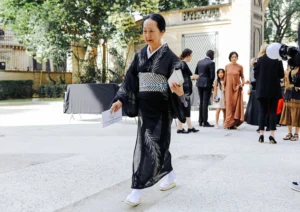The Evolution of Japanese Fashion: From Kimono to Street Style
- By -Maria Mash
- Posted on
- Posted in Culture
The Evolution of Japanese Fashion. The kimono is the most iconic and traditional form of Japanese clothing, representing centuries of culture, history, and craftsmanship. Originating in the Heian period (794-1185), the kimono evolved over time to reflect societal norms, social status, and even seasons. Made from silk, cotton, or synthetic fabrics, kimonos are characterized by their T-shaped design, wide sleeves, and intricate patterns. Each kimono tells a story through its colors, motifs, and styles, often reflecting the wearer’s age, gender, marital status, and the occasion it is worn for. While the kimono is no longer everyday wear, it remains an important part of Japanese culture and is still worn on special occasions such as weddings, tea ceremonies, and festivals.

The Influence of Western Fashion in Japan
The late 19th century marked a turning point for Japanese fashion as Western influences began to make their way into Japan. After the Meiji Restoration in 1868, Japan opened its doors to the West, resulting in significant cultural and social changes. Western clothing became increasingly popular, especially among men, as a symbol of modernization and progress. By the early 20th century, Western-style suits and dresses had become commonplace, particularly in urban areas. The blending of Western and traditional styles led to the creation of unique hybrid fashions, such as the “haikara” (high-collar) style, which combined Western blouses with traditional hakama skirts. This period of cultural exchange laid the foundation for Japan’s future as a fashion innovator.
The Birth of Modern Japanese Fashion
The post-World War II era marked a new chapter in Japanese fashion as the country underwent rapid economic growth and modernization. The 1960s and 1970s saw the rise of Japanese designers like Kenzo Takada, Issey Miyake, Yohji Yamamoto, and Rei Kawakubo, who brought Japanese fashion to the global stage. These designers challenged conventional fashion norms with their avant-garde styles, innovative use of materials, and deconstructionist approaches. Their work redefined fashion, merging Japanese aesthetics with Western influences to create something entirely new and distinct. This era also saw the emergence of the “kawaii” culture, characterized by cute and playful clothing, which became a significant aspect of Japanese fashion.
The Emergence of Japanese Street Fashion
The 1980s and 1990s saw the explosion of Japanese street fashion, a dynamic and diverse style movement that continues to evolve today. Harajuku, a district in Tokyo, became the epicenter of this fashion revolution, where young people began experimenting with bold colors, patterns, and eclectic combinations. Subcultures like “Gyaru,” “Lolita,” “Visual Kei,” and “Decora” emerged, each with its own unique style and philosophy. These styles were characterized by a mix of Western and Japanese influences, DIY fashion, and a rejection of mainstream fashion norms. The street style movement celebrated individuality, creativity, and self-expression, making Japanese fashion one of the most diverse and influential scenes globally.
Lolita Fashion: A Unique Expression of Femininity
One of the most distinctive subcultures to emerge from Japanese street fashion is Lolita fashion, which draws inspiration from Victorian and Rococo-era clothing. Lolita fashion is characterized by frilly dresses, petticoats, lace, and elaborate accessories that create a doll-like appearance. This style is further divided into various substyles, such as “Gothic Lolita,” “Sweet Lolita,” and “Classic Lolita,” each with its own unique color schemes, motifs, and aesthetic elements. Lolita fashion is more than just clothing; it represents a cultural statement and a form of escapism for those who embrace it. It challenges traditional gender norms and societal expectations, offering a space for self-expression and creativity.
The Minimalist Movement in Japanese Fashion
While Japanese street fashion is known for its bold and eclectic styles, the minimalist movement has also gained prominence in recent years. Designers like Yohji Yamamoto, Rei Kawakubo, and Issey Miyake have championed minimalist fashion, characterized by simple lines, monochromatic palettes, and innovative fabric techniques. This minimalist approach to fashion reflects the Zen principles of simplicity, balance, and harmony, which are deeply rooted in Japanese culture. The minimalist trend has found a global audience, influencing both high fashion and everyday wear with its timeless, versatile designs that emphasize comfort, functionality, and understated elegance.
Japanese Fashion on the Global Stage
Japanese fashion designers have continued to make a significant impact on the global fashion industry. Brands like Comme des Garçons, Sacai, Undercover, and A Bathing Ape have garnered international acclaim for their unique approach to design, blending tradition with modernity. Japanese fashion is celebrated for its ability to challenge conventions, push boundaries, and redefine the concept of style. The success of Japanese designers on the global stage has also led to a growing interest in Japanese fashion brands, vintage kimonos, and traditional crafts, further highlighting the influence of Japanese culture on global fashion trends.
The Role of Technology in Modern Japanese Fashion
Japan has always been at the forefront of technological innovation, and this extends to the fashion industry as well. Modern Japanese designers are increasingly incorporating technology into their creations, from advanced fabrics and textiles to wearable tech and 3D printing. Designers like Issey Miyake have pioneered the use of pleats and innovative fabric technologies that allow for movement and versatility. The integration of technology in fashion has led to the development of functional, sustainable, and avant-garde designs that continue to push the boundaries of what fashion can be. This fusion of fashion and technology positions Japan as a leader in the future of fashion.
The Influence of Japanese Fashion on Global Streetwear
Japanese fashion has had a profound impact on the global streetwear scene, particularly through the influence of brands like A Bathing Ape (BAPE), Neighborhood, and WTAPS. These brands have redefined streetwear with their distinctive aesthetics, attention to detail, and commitment to quality. Japanese streetwear blends elements of Western hip-hop culture, military wear, and traditional Japanese craftsmanship, creating a unique style that has resonated with fashion enthusiasts worldwide. The popularity of Japanese streetwear has also led to collaborations with global brands like Nike, Adidas, and Supreme, further cementing its status as a major player in the fashion industry.
Conclusion
Japanese fashion has undergone a remarkable evolution, from the traditional elegance of the kimono to the bold creativity of modern street style. This journey reflects Japan’s unique ability to blend tradition with innovation, creating a fashion culture that is both deeply rooted in its history and constantly evolving. The influence of Japanese fashion extends beyond its borders, inspiring designers and fashion enthusiasts around the world with its emphasis on creativity, individuality, and craftsmanship. As Japanese fashion continues to evolve, it will undoubtedly remain a significant force in shaping global fashion trends.



